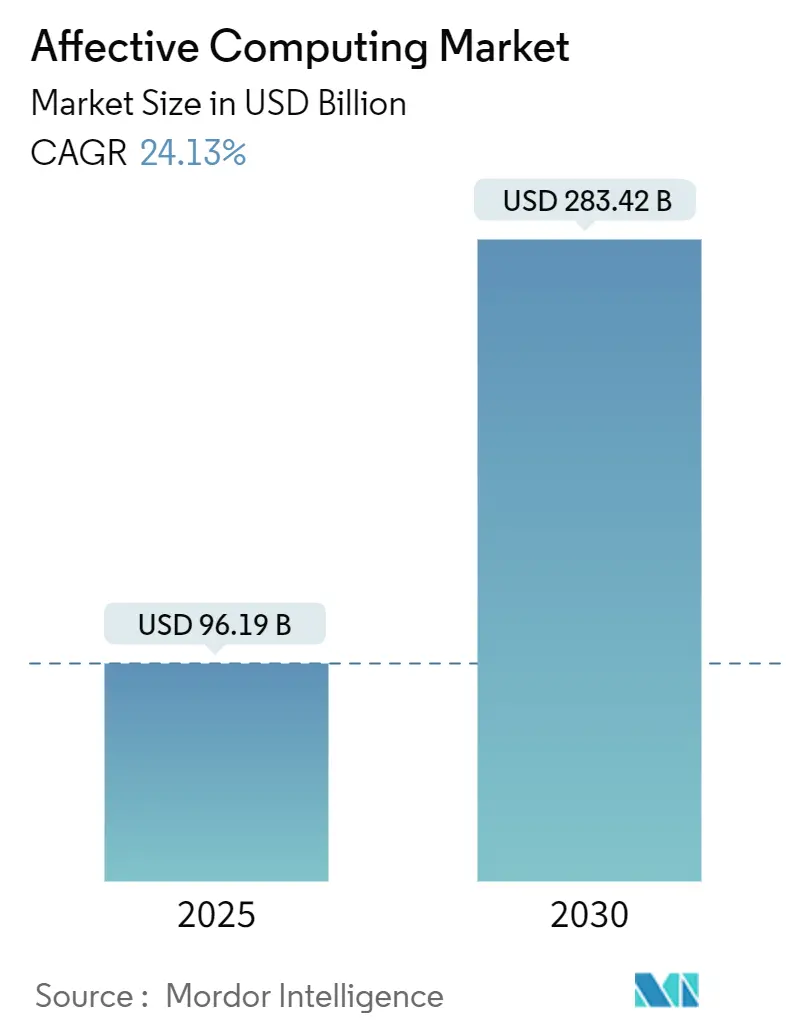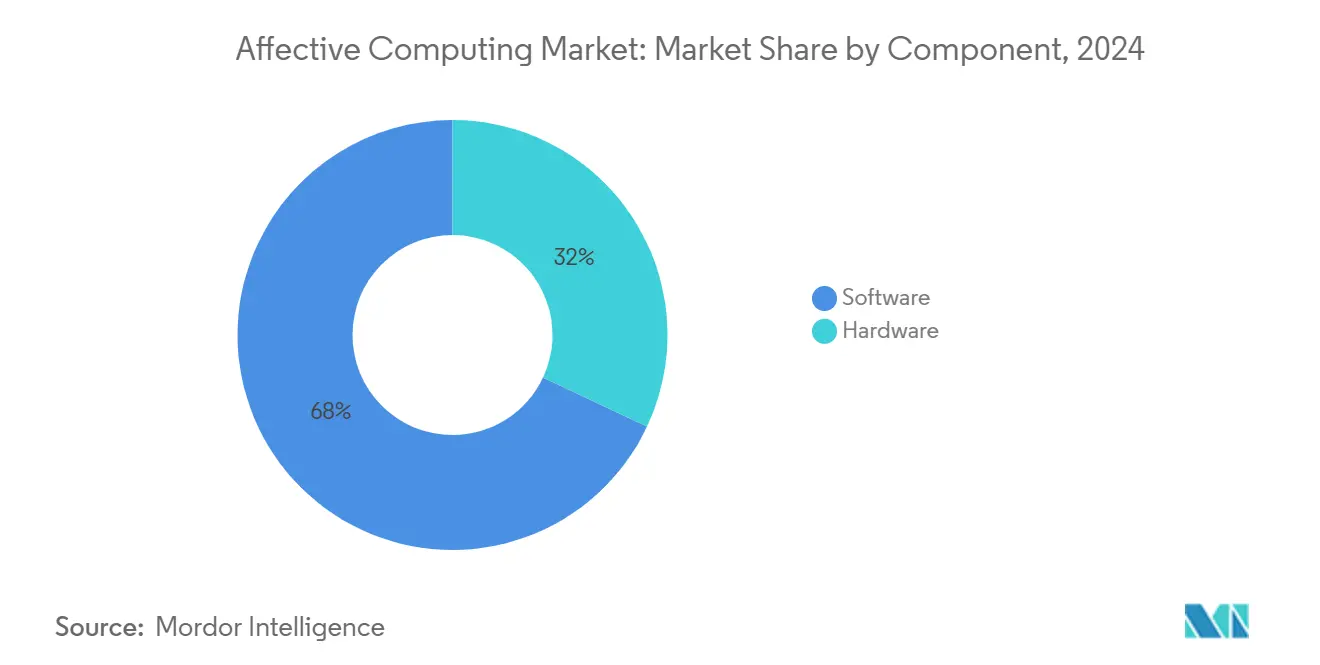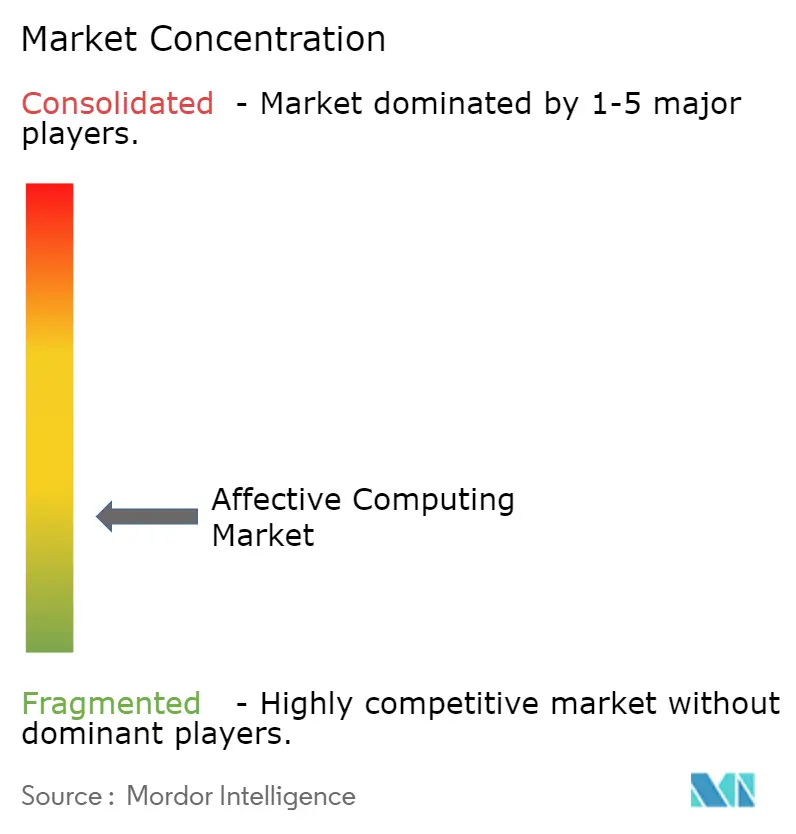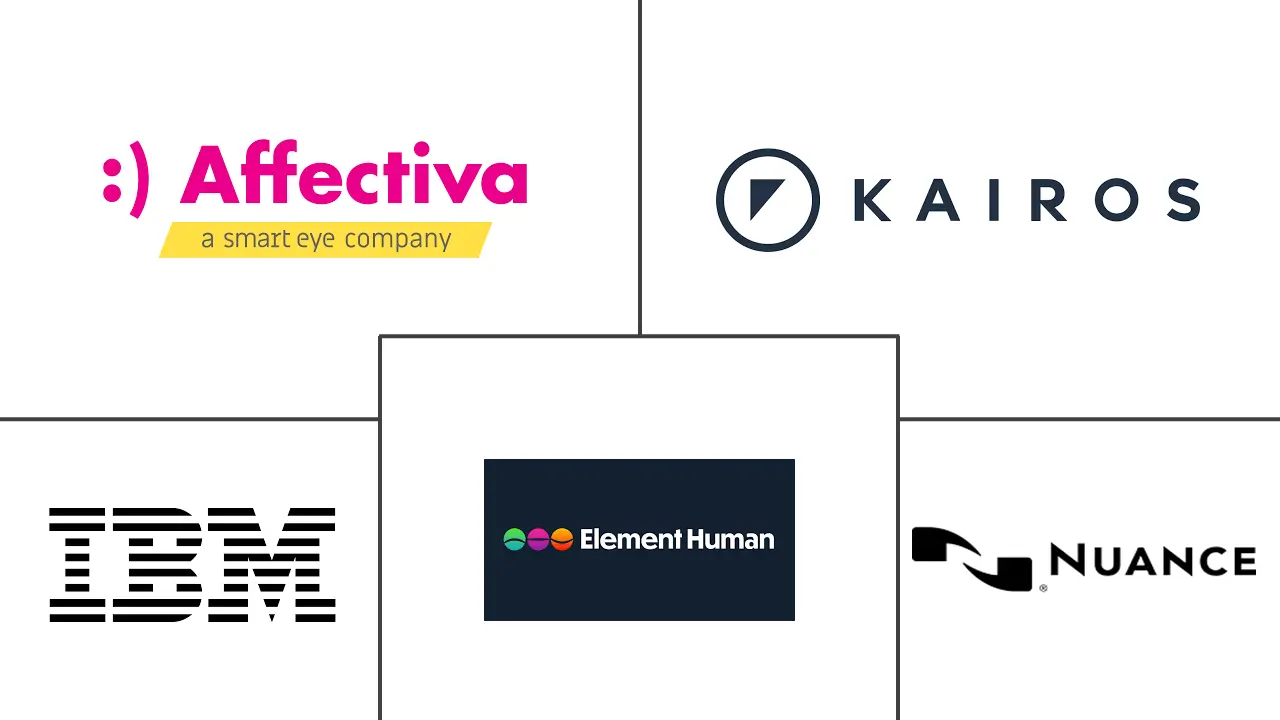Affective Computing Market Size and Share

Affective Computing Market Analysis by Mordor Intelligence
The affective computing market size reached USD 96.19 billion in 2025 and is forecast to climb to USD 283.42 billion by 2030, implying a CAGR of 24.13%. Developers are embedding on-device AI chipsets that cut latency and energy draw, multimodal analytics that merge facial, vocal and physiological cues, and edge-first deployments that reduce privacy worries and deliver real-time emotion intelligence in consumer electronics. Momentum also comes from widening healthcare and automotive use cases, where emotion data improves mental-health outcomes and elevates in-cabin safety. Hardware component costs have dropped sharply-sensor and camera prices slid 18% in 2024-broadening the base of devices that can host emotion algorithms. Regional regulation shapes go-to-market strategies: strict European Union rules limit certain workplace applications, while relatively permissive frameworks in North America and Asia encourage broad experimentation, creating distinct product road maps for vendors across the affective computing market.
Key Report Takeaways
- By component, the software segment held 68% of the affective computing market share in 2024 and is advancing at a 26% CAGR through 2030.
- By end-user industry, healthcare led with 30% revenue share in 2024, while automotive is tracking the fastest 29% CAGR to 2030.
- By geography, North America captured 38% of the affective computing market size in 2024; Asia-Pacific is projected to expand at a 28% CAGR between 2025 and 2030.
Global Affective Computing Market Trends and Insights
Drivers Impact Analysis
| Driver | (~) % Impact on CAGR Forecast | Geographic Relevance | Impact Timeline |
|---|---|---|---|
| Expanding on-device AI capabilities | +5.2% | Global, strongest in North America & East Asia | Medium term (2-4 years) |
| Multimodal emotion analytics in retail centers | +4.3% | North America, Europe, China | Medium term (2-4 years) |
| Automotive OEM mandates for in-cabin monitoring | +3.8% | North America, Europe | Short term (≤2 years) |
| Surge in telehealth reimbursements for emotion logging | +3.5% | North America, Europe | Medium term (2-4 years) |
| Contact-center voice sentiment scoring | +2.9% | Asia-Pacific, global spillover | Short term (≤2 years) |
| Media-streaming emotion A/B testing | +2.6% | Global | Medium term (2-4 years) |
| Source: Mordor Intelligence | |||
Deployment of Multimodal Emotion Analytics in Retail Experience Centers
Retailers blend facial cues, vocal tone and physiological signals to craft context-aware product recommendations. A peer-reviewed study found that adding emojis and facial-expression feedback to e-commerce reviews lifted purchase intention and enjoyment by 27% compared with text-only formats.[1]Intel Corporation, “Intel Extends Leadership in AI PCs and Edge Computing at CES 2025,” intel.com Neuro-symbolic Q-learning engines that adjust prices in real time according to shopper sentiment boosted engagement 14% and brand reputation 9%. Luxury boutiques employ the data to deepen emotional affinity, and fast-fashion chains refine new-design rollouts, making retail one of the more dynamic contributors to the affective computing market. The trend resonates most in North America and China, both of which combine mature omni-channel systems with high digital-payment penetration.
Automotive OEM Mandates for In-Cabin Driver Monitoring (U.S., EU)
Regulations on both sides of the Atlantic require vision-based systems to detect distraction, fatigue and impairment. Direct camera solutions identify drowsiness 4.2 seconds faster than steering-input methods, according to field-test data. The European Union General Safety Regulation already obliges new vehicles to embed such functions, and United States legislation under the SAFE Act is shaping similar mandates. Ratings agencies now grade partial-automation features on driver monitoring, adding commercial incentives. Automakers extend the same sensor suite to atmosphere control, infotainment and seat comfort, transforming safety features into premium in-cabin experience platforms and enlarging the affective computing market.
Surge in Telehealth Reimbursements Requiring Patient Emotion Logging
Payers in the United States and parts of Europe reimburse virtual visits that capture emotional data, widening demand in mental-health and chronic-pain care. Research published in Frontiers in Psychiatry showed that late-life mood-disorder screening accuracy improves when voice and facial analytics supplement questionnaires.[2]Rajab Ghandour, “Multimodal Presentation of E-commerce Product Reviews and Ratings,” emerald.com Rural providers adopt these tools to offset specialist shortages, while national health systems justify reimbursements with outcome gains. Higher license volumes for compliant telehealth platforms reinforce the long-term growth trajectory of the affective computing market.
Expanding On-Device AI Capabilities Propelled by Edge-Computing Chipsets
Intel’s Core Ultra processors unveiled at CES 2025 integrate neural processing units that boost AI performance 45% while trimming power use 38%, enabling real-time emotion recognition on mainstream laptops and tablets The architecture removes network hops, safeguards user privacy and meets strict latency thresholds demanded by driver-monitoring and telehealth workflows. Qualcomm’s latest AI Engine offers similar gains for smartphones and automotive platforms, lowering entry barriers for developers pursuing the affective computing market. Spending on edge AI platforms is forecast to surge, with emotion-aware workloads among the most prolific volume drivers. As these capabilities arrive pre-installed in consumer devices, development cycles shorten and time-to-market for emotion-enabled services accelerates within the affective computing market.
Restraints Impact Analysis
| Restraint | (~) % Impact on CAGR Forecast | Geographic Relevance | Impact Timeline |
|---|---|---|---|
| Algorithmic bias litigation risk | −2.4% | European Union, California | Short term (≤2 years) |
| Lack of emotion-data interoperability standards | −1.8% | Global | Medium term (2-4 years) |
| High-bandwidth edge needs in rural facilities | −1.5% | Rural zones worldwide | Medium term (2-4 years) |
| Stringent biometric-consent laws | −1.2% | Illinois, Texas, EU | Short term (≤2 years) |
| Source: Mordor Intelligence | |||
Algorithmic Bias Litigation Risk in EU &andCalifornia
The EU AI Act classifies most workplace and classroom emotion analytics as an unacceptable risk unless used for safety or health, and California's privacy laws mirror this stance.[3]Brownstein Hyatt Farber Schreck LLP, "EU Takes Steps Toward Regulating Use of Artificial Intelligence with the AI Act," bhfs.com Studies published in Nature warn that bias in emotion algorithms can intensify discrimination during recruitment. Enterprises therefore face litigation exposure, forcing vendors to invest in privacy-preserving workflows and diverse training datasets, which slows rollouts within regulated regions of the affective computing market.
Absence of Global Standard for Affective Data Interoperability
A meta-review covering 410 trimodal studies highlights inconsistent data schemas that complicate cross-platform integration.[4]Hussein Farooq Tayeb Al-Saadawi et al., “Trimodal Affective Computing Approaches,” doi.org Without shared ontologies, healthcare providers struggle to merge emotion metrics into electronic health records, inflating project costs. AffectEval, released in 2025, offers a modular workaround yet requires broad acceptance to unlock economies of scale. Lack of standards therefore restrains the affective computing market.
Segment Analysis
By Component: Software Extends Revenue Lead Across Edge Devices
Software captured 68% of the affective computing market share in 2024, a lead it has preserved as developers deploy lightweight facial-, speech- and text-analysis engines on existing hardware. Rapid algorithm iteration allows vendors to release quarterly upgrades that raise accuracy without requiring new sensors, keeping total cost of ownership low for enterprises. Commercial APIs slot into data-science stacks written in Python or JavaScript, shortening build cycles for digital-health dashboards and retail recommendation engines. Contact-center supervisors feed real-time voice sentiment scores directly into customer-experience metrics, while insurance carriers layer emotion classifiers onto claims-video triage to flag potential fraud.
Hardware price compression reinforces software momentum. Edge neural-processing units that once required USD 50 now list near USD 17, lowering barriers for mid-range laptops and infotainment consoles. Miniaturized photoplethysmography and galvanic-skin-response sensors embed inside steering wheels with no design penalty, yet licence fees for the embedded analytics still flow to software vendors, keeping them atop the affective computing market. The widening base of addressable devices strengthens network effects around pretrained models and data-labeling pipelines, suggesting software will hold its dominant share through 2030.

By End-User Industry: Healthcare Retains the Largest Wallet Share
Healthcare generated 30% of 2024 revenue as clinicians used multimodal affective scores to flag depression, titrate pain medication and track therapy adherence. One hospital network logged a 12-minute reduction in triage time after integrating speech-driven distress detection into tele-ICU consoles, freeing capacity for critical interventions. Oncology units overlay facial micro-expressions onto electronic health records to refine morphine dosing schedules, while geriatric psychologists rely on voice quiver indices to anticipate anxiety spikes among dementia patients.
Automotive currently grows fastest at a 29% CAGR because regulations transform driver-monitoring from a luxury feature into a compliance line item. OEMs now connect mood indicators with ambient-light strips and adaptive HVAC profiles, elevating cabin experience scores in premium models. Retail chains rank third, testing multimodal kiosks that adjust promo imagery in real time according to shopper sentiment. The affective computing industry also gains traction in financial services, where risk-management desks blend text polarity with trader voice stress to modulate position limits.
Geography Analysis
North America accounted for 38% of the affective computing market size in 2024, reflecting mature cloud infrastructure and a policy climate that permits broad experimentation outside of states with stringent biometric statutes. United States hospitals moved early because Medicare and major private payers reimbursed emotion-rich teleconsultations, which lifted platform licence volumes. Technology companies based on the West Coast partner with chip designers to push on-device inference that minimizes latency for driver-monitoring and gaming peripherals, while East Coast insurers run pilot projects that mesh voice sentiment and claims data to flag potential false statements.
Asia-Pacific is projected to post a 28% CAGR through 2030, the fastest regional clip in the affective computing market. China directs university–industry alliances toward smart-city corridors that synchronize lighting and digital billboards with crowd emotion, raising pedestrian satisfaction ratings. Japan and South Korea bundle driver mood detection into flagship sedans to differentiate cabin comfort, leveraging decades of sensor-fusion expertise. India’s BPO hubs overlay real-time voice stress scores onto agent dashboards to improve first-call resolution metrics, a move that wins renewals from global telecom and banking clients. Southeast Asian e-commerce giants deploy emoji-based review prompts that heighten purchase intention, showing the cultural versatility of emotion cues.
Europe’s trajectory remains mixed after the EU AI Act curtailed workplace and classroom use of emotion recognition. Enterprises pivoted toward automotive and healthcare exemptions, and Germany now leads cross-continental research on multimodal driver fatigue detection. The United Kingdom, outside EU jurisdiction, maintains a regulatory sandbox that encourages tele-mental-health pilots, while Nordic hospitals study pain-emotion indices to refine opioid stewardship. Brussels published a 2025 Action Plan that funds software-defined vehicle stacks, signaling long-term upside for compliant emotion-aware cabins across the affective computing market.

Competitive Landscape
Incumbent hyperscalers, niche algorithm specialists and academic spin-offs vie for contracts, yielding moderate concentration. Microsoft’s acquisition of Nuance in 2024 embedded medical speech sentiment into Azure’s healthcare cloud, giving the platform a head start in HIPAA-aligned emotion analytics. Google licenses its Multisensory Transformer to automotive suppliers, while Meta funds open-source affective datasets to seed future AR use cases.
Specialists carve out modality depth. audEERING dominates acoustic emotion tagging for media archives, publishing an audio stress corpus that underpins multiple entertainment-industry pilots. EMVAS combines eye-gaze, facial micro-motion and keystroke cadence to flag fatigue in industrial control rooms, tripling pilot conversions during 2024. Sensor firms such as Omnivision pair high-dynamic-range cameras with embedded vision pipelines to deliver turnkey in-cabin kits.
Consolidation is expected to accelerate as vendors seek access to diverse data and global distribution. Lyken.AI, rebranded in May 2025, announced a full-stack platform that bundles edge agents, cloud orchestration and compliance toolkits, aiming to cut enterprise deployment cycles by half. Middleware gaps persist around interoperability; companies that resolve schema mismatches between raw biosignals and sentiment dashboards could command premium valuations.
Affective Computing Industry Leaders
-
Affectiva Inc.
-
IBM Corporation
-
Nuance Communications Inc.
-
Element Human Ltd
-
Kairos AR Inc.
- *Disclaimer: Major Players sorted in no particular order

Recent Industry Developments
- May 2025: Alset AI Ventures rebranded Cedarcross as Lyken.AI to build a platform-as-a-service for AI infrastructure, aligning with forecast AI capital expenditure growth to USD 356.14 billion by 2032.
- May 2025: Secure Privacy released a GDPR-compliant blueprint for multimodal emotion recognition pipelines.
- April 2025: AffectEval reduced manual coding for emotion pipelines by up to 90% and now handles visual, auditory and textual inputs.
- March 2025: Xiao-I and TF International partnered to blend Hua Zang LLM with affective analytics for investment research
- March 2025: The European Commission issued an Action Plan supporting software-defined vehicles with emotion-aware cabins.
- January 2025: Intel introduced Core Ultra processors with integrated NPUs that boosted on-device emotion-recognition speed 45% and cut power use 38%.
Global Affective Computing Market Report Scope
Affective computing can be defined as the study of and creation of technologies for simulating, analyzing, and interpreting human emotions. The market for the study defines the revenues accrued from the sales of affective computing solutions across various end-users, including healthcare, automotive, retail, etc.
The affective computing market is segmented by component (hardware (sensors, cameras, storage devices, and processors), software (analytics software, enterprise software, facial recognition, gesture recognition, and speech recognition)), end-user industry (healthcare, automotive, and retail), and geography (North America, Europe, Asia-Pacific, and the rest of the world). The market sizes and forecasts are provided in terms of value (USD) for all the above segments.
| Hardware | Sensors |
| Cameras | |
| Storage Devices and Processors | |
| Other Components | |
| Software | Analytics Software |
| Enterprise Software | |
| Facial Recognition | |
| Gesture Recognition | |
| Speech Recognition |
| Healthcare |
| Automotive |
| Retail |
| Government and Public Sector |
| BFSI |
| Other End-user Industries |
| North America | United States |
| Canada | |
| Mexico | |
| South America | Brazil |
| Argentina | |
| Chile | |
| Peru | |
| Rest of South America | |
| Europe | Germany |
| United Kingdom | |
| France | |
| Italy | |
| Spain | |
| Rest of Europe | |
| Asia-Pacific | China |
| Japan | |
| South Korea | |
| India | |
| Australia | |
| New Zealand | |
| Rest of Asia-Pacific | |
| Middle East | United Arab Emirates |
| Saudi Arabia | |
| Turkey | |
| Rest of Middle East | |
| Africa | South Africa |
| Rest of Africa |
| By Component | Hardware | Sensors |
| Cameras | ||
| Storage Devices and Processors | ||
| Other Components | ||
| Software | Analytics Software | |
| Enterprise Software | ||
| Facial Recognition | ||
| Gesture Recognition | ||
| Speech Recognition | ||
| By End-user Industry | Healthcare | |
| Automotive | ||
| Retail | ||
| Government and Public Sector | ||
| BFSI | ||
| Other End-user Industries | ||
| By Geography | North America | United States |
| Canada | ||
| Mexico | ||
| South America | Brazil | |
| Argentina | ||
| Chile | ||
| Peru | ||
| Rest of South America | ||
| Europe | Germany | |
| United Kingdom | ||
| France | ||
| Italy | ||
| Spain | ||
| Rest of Europe | ||
| Asia-Pacific | China | |
| Japan | ||
| South Korea | ||
| India | ||
| Australia | ||
| New Zealand | ||
| Rest of Asia-Pacific | ||
| Middle East | United Arab Emirates | |
| Saudi Arabia | ||
| Turkey | ||
| Rest of Middle East | ||
| Africa | South Africa | |
| Rest of Africa | ||
Key Questions Answered in the Report
What fuels the affective computing market’s rapid growth?
On-device AI chipsets, multimodal analytics and strong ROI in healthcare and automotive collectively underpin a 24.13% CAGR to 2030.
Which component drives current revenue?
Software leads with 68% of 2024 revenue because algorithms deploy on existing hardware without specialized sensors.
How big is the market in 2025?
The affective computing market size reached USD 96.19 billion in 2025 and is projected to hit USD 283.42 billion by 2030.
Which region is expanding fastest?
Asia-Pacific is forecast to grow at a 28% CAGR from 2025-2030, led by Chinese smart-city deployments and automotive advances in Japan and South Korea.
What sector shows the strongest future demand?
Automotive posts the highest 29% CAGR outlook as driver-monitoring mandates evolve into full cabin-experience platforms.
How do regulations shape adoption?
The EU AI Act restricts workplace emotion analytics, steering European innovation toward healthcare and automotive, while North American and Asian frameworks permit wider experimentation.
Page last updated on:



